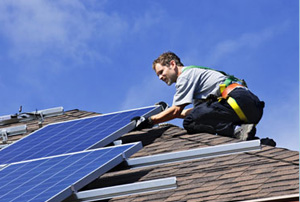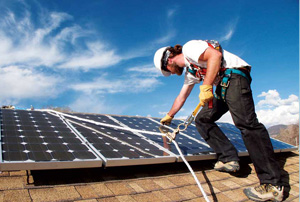Solar Questions and Answers
Q: What is photovoltaics (solar electricity) or "PV"?
A: What do we mean by photovoltaics? The word itself helps to explain how photovoltaic (PV) or solar electric technologies work. First used in about 1890, the word has two parts: photo, a stem derived from the Greek phos, which means light, and volt, a measurement unit named for Alessandro Volta (1745-1827), a pioneer in the study of electricity. So, photovoltaics could literally be translated as light-electricity. And that's just what photovoltaic materials and devices do; they convert light energy to electricity, as Edmond Becquerel and others discovered in the 18th Century.
Q: How can we get electricity from the sun?
A: When certain semiconducting materials, such as certain kinds of silicon, are exposed to sunlight, they release small amounts of electricity. This process is known as the photoelectric effect. The photoelectric effect refers to the emission, or ejection, of electrons from the surface of a metal in response to light. It is the basic physical process in which a solar electric or photovoltaic (PV) cell converts sunlight to electricity.
Sunlight is made up of photons, or particles of solar energy. Photons contain various amounts of energy, corresponding to the different wavelengths of the solar spectrum. When photons strike a PV cell, they may be reflected or absorbed, or they may pass right through. Only the absorbed photons generate electricity. When this happens, the energy of the photon is transferred to an electron in an atom of the PV cell (which is actually a semiconductor).
With its newfound energy, the electron escapes from its normal position in an atom of the semiconductor material and becomes part of the current in an electrical circuit. By leaving its position, the electron causes a hole to form. Special electrical properties of the PV cell a built-in electric field provide the voltage needed to drive the current through an external load (such as a light bulb).
Q: What are the components of a photovoltaic (PV) system?
A: A PV system is made up of different components. These include PV modules (groups of PV cells), which are commonly called PV panels; one or more batteries; a charge regulator or controller for a stand-alone system; an inverter for a utility-grid-connected system and when alternating current (ac) rather than direct current (dc) is required; wiring; and mounting hardware or a framework.
Q: How long do photovoltaic (PV) systems last?
A: A PV system that is designed, installed, and maintained well will operate for more than 20 years. The basic PV module (interconnected, enclosed panel of PV cells) has no moving parts and can last more than 30 years. The best way to ensure and extend the life and effectiveness of your PV system is by having it installed and maintained properly. Experience has shown that most problems occur because of poor or sloppy system installation.
No Cost / Obligation
Solar Evaluation
To maximize the effect of solar energy off-setting power consumption from the grid, an integrated plan must be developed.
read moreBefore installing anything, we analyze your home, roof, location, and surroundings to ensure the maximum benefit and cost savings.
read moreModeling is the last of the pre-installation phase and is where the vision of your new energy-efficient home takes shape.
read moreThe last phase of the process and the last step before you have a new energy efficient home! Our team loves installing!
read more


